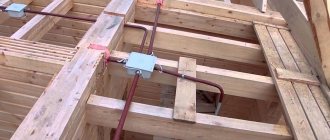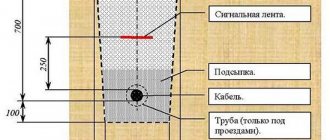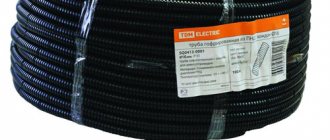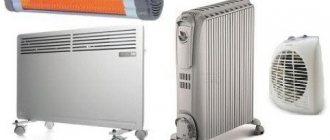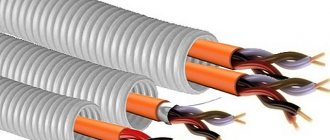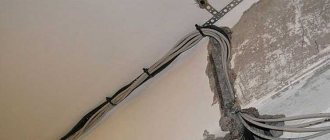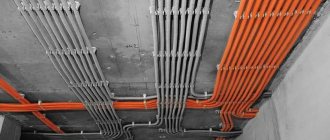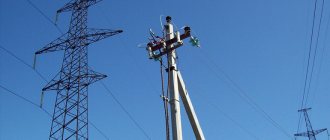During electrical installation work, electrical wiring is sometimes performed in an open manner. The cable must be protected from thermal and mechanical influence. It is important to ensure aesthetics and create a neat appearance of electrical networks. For these purposes, a corrugated tube is used. In professional language, this material is “corrugation”.
Corrugated wiring on the ceiling Source 5watt.ua
Errors and rules for cable installation
The most common mistakes made by electricians when laying cable networks stretched inside the corrugation are:
- Creating sharp corners.
It is necessary to lay the routes in such a way that the corner transitions are flexible. Sharp corners should not be allowed when turning.
- No special components are used to increase the length.
When you need to make an entire section of wiring longer, you need to use tees, transit boxes, and couplings.
- The corrugation is connected using electrical tape.
According to the PUE, it is unacceptable to connect 2 corrugated pipes with each other using insulating tape. There are connecting components for this. This applies to turns, corners, and the middle of a long section.
- One corrugation has been laid, into which several lines of power cables are stretched.
This is a very serious mistake made by electricians. According to the PUE, it is correct when each cable power line is pulled into a separate corrugated pipe. It is unacceptable to lay several conductors in a corrugated cable at once.
Wiring output Source arte.net.ua
Types of corrugations for electrical cables
Corrugated hoses for electrical wiring are used when installing open wiring, when laying lines on the street or in a channel formed in a wooden wall. Corrugated pipes are produced from various plastics and metals. There are also composite options made of iron wrapped in a layer of PVC.
It is recommended to choose one sleeve for the street, another for installation in a screed or ground, and a third for installation behind interior cladding.
If the wiring is laid in a dusty room and the channel for it requires a sealed one, then it is best to take a plastic sleeve - the joints between it and distribution panels and boxes are much easier to seal
All corrugations based on strength, wall thickness and design are divided into:
- lightweight (withstand loads up to 320 N/5 cm2) – thin-walled, flexible and fragile, designed for installation under sheathing on ceilings and walls;
- medium (designed for loads up to 750 N/5 cm2) – recommended for installation in wall grooves;
- heavy (withstand up to 1250 N/5 cm2) – thick-walled and rigid, used when installing wires in screeds on the floor;
- super-heavy reinforced (designed for 4000 N/5 cm2 and above) - hoses made of twisted steel wire and plastic sheaths, needed for laying cables underground and on the streets by hanging.
The thinner the walls of the corrugation, the softer and more flexible it is. However, as the flexibility of a corrugated hose increases, its resistance to mechanical damage decreases. At the same time, it is difficult to bend a pipe that is too thick at a right angle; it may simply break.
But such heavy corrugated hoses provide more reliable protection from moisture and dust. This is especially true when laying cables in the ground.
Type #1 - metal hose
When compared to plastics, metal is obviously a more advantageous option in terms of strength. It perfectly protects the cable from chemicals, moisture, ultraviolet radiation, shock and compression. And in the event of a fire, a metal hose will last much longer than its plastic counterpart.
A corrugated metal hose is more fireproof and reliable than its plastic competitor, but it should not be laid in the ground - rust will inevitably do its dirty work
Metal corrugations for laying cables are divided into several types:
- RZ-Ts, RZ-TsKh, RZ-TsA – made of galvanized steel.
- RZ-SL and RZ-SL-X - made of tinned steel tape (tin plated with tin).
- RZ-TsP – with PVC insulation.
The letter “X” in the first two options indicates the presence of a cotton seal, and “A” an asbestos-cement seal. The "P" in the latter type of corrugation indicates the outer layer of PVC.
Also, metal hoses for wires exist with flanges at the ends and welded ends. Plus, there are variations of high pressure hoses in explosion-proof versions and for high pressure.
Image gallery
Photo from
Wooden floor with wiring in a metal hose
Wiring under a suspended ceiling
Metal corrugation with polymer coating
Entering a power line into a wooden house
However, such corrugated pipes are more intended for industrial conditions. They are not used for installing electrical wiring in the house due to their high price and fundamental uselessness.
Conventional metal hoses are made from steel tape by winding it in a spiral. At the same time, the resulting corrugation is not airtight. When pressed firmly, the joints of the tape immediately separate and the sleeve simply falls apart.
The metal hose is ideal for installing electrical wiring in a wooden house and outdoors; here its main advantage (non-flammability) comes in handy
If you need a sealed metal sleeve, you should take a product with additional insulation made of polyvinyl chloride. In this case, the top layer of self-extinguishing plastic will definitely prevent moisture and dust from reaching the steel base.
Only such corrugations are recommended for use in bathrooms and outbuildings, where constant changes in humidity and temperature are the norm.
Type #2 - polyvinyl chloride (PVC)
Gray electrical corrugations made of PVC are characterized by low price and self-extinguishing. In the event of a fire, they not only do not burn, but thanks to the additives in the plastic, they go out on their own.
The main disadvantage of any polyvinyl chloride products is their poor tolerance to UV rays. Under the influence of the sun, this material begins to simply “deteriorate,” which sharply reduces their actual service life.
Corrugated PVC pipes should be used exclusively indoors for wiring electrical wires using hidden technology, laying them behind cladding or other decor.
Another disadvantage of PVC corrugated sheets is their intolerance to low and too high temperatures, as well as excess humidity. When frozen, this plastic becomes brittle. In the cold it is destroyed even from a slight blow.
And in extreme heat (and even if in the sun), the corrugated polyvinyl chloride sleeve begins to soften slightly and “flow”. This does not lead to its immediate destruction or damage, but its service life is sharply reduced due to such operating conditions.
The situation is similar with water. With constant exposure to moisture, the walls of such corrugations begin to gradually collapse. These PVC pipes for water supply are initially designed for such an impact, but corrugated hoses have slightly different characteristics.
If the wiring needs to be laid in the bathroom or outdoors in direct sunlight, then it is better to look for another cable channel option for it.
Corrugated PVC pipes are ideal for installing wires in dry, heated rooms. They are cheap and flexible, and installation should not be difficult. But their gray appearance frankly does not please with its presentability and aesthetics.
Image gallery
Photo from
Wiring device behind a false wall
Laying wiring packages along the ceiling
Embedding of polymer corrugated hose
Gasket in brackets for suspended ceilings
It is best to cover such corrugations on top with finishing (wall panels, plaster with wallpaper on top or clapboard).
Type #3 - polyethylene and polypropylene
Corrugations made from HDPE polyethylene (or LDPE) and PPR polypropylene are approximately equal in cost and characteristics. They are resistant to strong moisture, temperature changes and ultraviolet rays. Such corrugated sleeves are universal.
They can be used both indoors and outdoors. For example, when installing a heating cable connection line, an electrical panel when entering a site, outdoor lighting branches, activating an irrigation system, etc.
In many properties, polypropylene and polyethylene are similar, their main difference is that PP cable sleeves are self-extinguishing, while PE sleeves are flammable
Both versions of these electrical corrugated hoses feel comfortable at air temperatures in the range of -40...+45 degrees Celsius. At the same time, HDPE is famous for its resistance to oils, acids and solvents.
It is recommended to use corrugated products made from it in garages, utility rooms and on the streets - that is, anywhere where aggressive technical liquids can get on the wires.
Laying corrugated cable
The finished corrugated pipe is laid along the ceiling using special clips. The diameter of this part is selected taking into account the cross-section of the selected material. This option for attaching a corrugated pipe to the ceiling looks more aesthetically pleasing. For invisible, internal places, special metal brackets are mainly used. These parts are secured using electrical dowels.
To connect 2 corrugated pipes, couplings are used. They are cheap. In the case where in this section an integral cable line that does not have connections is stretched inside the corrugated protection, according to the PUE, those sections where the pipe is attached to the coupling are allowed to be sealed with a sealant. Otherwise, you need to choose other insulation methods that are considered the most reliable. When laying, do not bend the corrugated pipe too much. The acceptable parameter is printed by the manufacturer on the packaging box of the material.
Corrugation in section Source media2.24aul.ru
Standards and rules for laying cables in corrugated cables
The requirements of state regulatory documents do not directly indicate the need to lay electrical cables in corrugation. However, from some standards one can draw clear conclusions about the use of corrugated pipes. For example:
- in table 2.1.3 PUE
(Fig. 1) it is recommended to install unprotected and protected cable and wire products in pipes made of difficult/non-combustible materials;
Fig.1
— clause 7.1.37 PUE
indicates that electrical wiring in the premises must be replaceable. It is easier to do this if the method of pulling the cable in a corrugation is used, because the procedure for replacing an electrical line that is laid in a groove or embedded is very labor-intensive;
— clause 3.58 SNiP 3.05.06-85
obliges to take measures to protect cable lines from mechanical damage.
Laying cable lines in a protective corrugation: errors and misconceptions
When performing electrical installation work, regardless of the chosen method, there is a universal requirement regarding:
- soldering process;
- terminal installations;
- crimping wires at joints.
Access should be provided for inspection of contact sections of cable lines. Therefore, when installing a corrugated pipe with a cable, distribution boxes are installed for installing joints.
According to the PUE, it is necessary to separate the main cable line from the backup one. For this purpose, they use different corrugated pipes. This also applies to working and emergency lighting cores. Corrugations with such wires are necessarily separated geographically.
Plastic corrugation does not belong to the category of fireproof products. They can be laid inside a brick or concrete wall (they need to be tapped).
In any case, for example, when passing hidden wiring through wood (if the house is wooden), you need to use fireproof gaskets:
- plastered;
- cement;
- asbestos.
The spacer layer will allow you to separate the corrugation from the wall surface by about 10 mm (less than that is not allowed according to the PUE). If you choose a plastic corrugated pipe for laying a line on a fireproof surface, you must ensure a distance from combustible places of no less than 10 cm.
What is corrugation and where is it used?
An electrical installation corrugation is a corrugated pipe for laying an electrical cable for the purpose of protecting it or protecting structures. Laying electrical cables in corrugated tubes is used in various situations with open or hidden electrical wiring.
Hidden gasket
Hidden installation is the installation of electrical wiring inside the structures of walls, floors and ceilings, behind finishing materials. It is conventionally divided into the following types of installation:
Laying inside non-combustible structures is carried out in grooves of walls and ceilings, in floor screeds or simultaneously with the installation of load-bearing structures (for example, when concreting). In this case, corrugation is used for ease of installation, protection from cable crushing and the ability to replace electrical wiring without disturbing the finishing material, chipping or dismantling wall, ceiling or floor structures. When laying corrugated cables inside structures made of non-combustible materials, the PUE allows the use of any type of corrugated tubes.
Laying behind finishing materials or in false spaces has purposes similar to laying in non-combustible structures (protection from mechanical damage, the ability to replace wiring if necessary), but with the installation requirements being met, as when laying over combustible materials. The fact is that finishing materials often promote combustion, so the requirements for such installation are quite strict. It is important to use flame retardant or metal corrugations for such installation.
Underground installation is carried out during landscaping work for wiring electrical power lines to lighting fixtures and various equipment (sprinkler pumps, gate and door opening systems), when laying low-current networks for security systems or telephone lines, and in other situations. The main requirement for such installation of corrugated electrical cables is water resistance and high resistance to mechanical deformation (rigidity).
How to quickly pull a cable into a corrugated pipe?
To work you will need:
- strong, long rope (thread) from any material;
- a piece of fabric or rag;
- vacuum cleaner.
To pull the cable inside the corrugated pipe, take a rope or piece of fabric. Both elements are tied together in such a way that the rag is not squeezed. It is best to tie the fabric to the middle of the corrugated material.
Next, a vacuum cleaner is connected to one end. If the corrugated pipe is very thin, you can make an adapter from scrap materials. Now you can turn on the vacuum cleaner and bring a rag tied to a rope to the other edge. Due to the pressure of the vacuum cleaner, the fabric will enter the pipe. The thread is then unwound to ensure that it follows the rag. This must be done until the rag reaches the vacuum cleaner, passing through the entire corrugation.
At the next stage, the cable is threaded inside the corrugated pipe. To do this, its end is tied to a rope, then stretched along the entire length of the material.
This method is used at home to pull a cable through a corrugated pipe of small diameter.
Watch the process in the video:
Metal corrugations for cables, price and application
The metal model consists of zinc or steel strip.
This design will allow you to withstand the most difficult loads with a small thickness of metal walls. With such indicators, the model has a very flexible body (bends like a hose).
Application of the design
In what cases is a metal model used:
- The metal structure is used to protect against severe mechanical damage (for example, load from the ground or screed).
- Often used in buildings that burn quickly (for example, a wooden house, suspended ceiling and other similar structures).
- Where the pipeline and electricity intersect.
- In an aggressive environment.
- Also in places with the possibility of further replacement.
Note! To replace the wiring in the corrugation, you will need many junction boxes so that the broaching can be done in a straight line
Cost overview
In this section, we will analyze the average price of a booster compressor station with a diameter of 1.6 cm for different cities in Russia:
| Cities | Cost, rub. |
| Saint Petersburg | 601,96 |
| Chelyabinsk region | 596,00 |
| Ufa | 607,92 |
| Krasnoyarsk region | 569,00 |
| Krasnodar | 572,16 |
| Perm region | 584,08 |
| Novosibirsk | 625,80 |
| Ekaterinburg | 601,96 |
How to attach the corrugation to the ceiling?
To fasten corrugations with a cross-section from 16 to 25 mm, special clips are used. They come in 2 types:
- Open.
This type of clip looks like curved flat horns. The part holds the corrugated pipe due to its elasticity. On the side, the clips are equipped with couplings that allow you to connect them to each other. This makes installation and further maintenance of the electrical network easier.
Models with latches are used for corrugations with a diameter of more than 40 mm, as well as when installing cables along the ceiling.
- Closed.
This type of clip is similar to a simple clamp. The part presses the corrugated pipe to the surface to which it is attached. The process can be mechanized using a mounting gun. A clip of clips is placed there, then the electrician “shoots” the corrugation to the ceiling.
Electrical panel Source verchinskiy.ru
How to choose corrugation for wiring
To select a corrugation, you need to know the diameter of the electrical cable and the conditions under which the corrugated pipe will be laid. When choosing a diameter, consider the following recommendations:
- Corrugations with a diameter of 16 mm are used for lighting cables, switches or signal lines;
- corrugations with a diameter of 20-25 mm are used for sockets or for laying coaxial cable;
- for connection to distribution boxes, depending on the cable cross-section, from 25 to 32 mm;
- for laying cables to electrical panels, corrugation with a diameter of 32 mm should be used;
- for large cable diameters, corrugations with a diameter of 40 mm and above are used.
An indicative table of the dependence of the corrugation diameter on the cross-section and number of cores of an NYM or VVG electrical cable is presented below:
| Electrical cable cross-section, mm² | Number of cores, pcs | External diameter of corrugation, mm |
| 1,5 | 2/3/4/5 | 16/16/20/20 |
| 2,5 | 2/3/4/5 | 16/16/20/25 |
| 4 | 2/3/4/5 | 20/20/25/25 |
| 6 | 2/3/4/5 | 20/25/32/32 |
| 10 | 2/3/4/5 | 25/32/32/40 |
| 16 | 2/3/4/5 | 32/32/40/40 |
| 25 | 2/3/4/5 | 32/40/50/50 |
When choosing a corrugation, it is especially important to focus on the conditions in which the corrugated pipe with an electric cable will be installed and operated. Each material is suitable for different installation options. Briefly indicate the following materials and conditions for their use:
- PVC: dry and closed areas;
- PPR: wet rooms, street, underground installation;
- HDPE: wet rooms, street, underground installation;
- Metal: in any conditions;
- PA: in any conditions.
Basic rules for installing ceiling wiring
Installation work is carried out on the basis of a pre-developed plan. During its preparation it is necessary:
- determine the location of the local network connection to electricity;
- highlight points of electricity consumption;
- select a location for installing protective equipment.
- draw up a diagram of laying a cable line from the connection point to electricity consumers.
At the preliminary stage, the brand, section of corrugation and cable are selected. For these purposes, there is a special table that makes selection easier.
Rules for installing PVC pipes for electrical wiring with your own hands
Laying out an electrical network begins with a layout of sockets, automatic machines, lamps, switches, and connection points for stationary electrical equipment (stove, boiler, electric oven). All power supply lines must run either vertically or horizontally, at a distance of 20 cm from the ceiling, floor, door, and distribution boxes must be installed at branching points.
Regardless of the wiring installation method (behind a false wall, in grooves), there must be access to the boxes. Connecting wires is allowed only in junction boxes and under no circumstances inside the shell pipe.
When installing pipes for pouring into a screed or concrete wall, you must first securely secure the structure using metal clamps. When installing a pipeline in a groove in a brick wall, you can fix it with quick-setting plaster (alabaster) and then plaster it.
To install the pipe shell outdoors, metal clamps are used; inside the building, plastic clips are used.
During installation, any pipes must fit into the opening of boxes, sockets, switches; gaps between the box and the pipe are not allowed.
In damp rooms, outdoors and in the ground, sealed pipes are used for installing electrical wiring. At the joints of pipes and distribution boxes, special seals are used (you can additionally coat them with sealant, for example, silicone). When laying open communications in dry rooms, the use of seals is not necessary.
If the electrical wiring is installed near the heating system, then when crossing, the distance from the heating should be at least 5 cm, and if the pipes run parallel, then the distance should be at least 10 cm.
You cannot bend pipes with a small turning radius; when bending, you must comply with the standard radius and use a pipe bender or templates. There should be no cracks, folds, or creases at the bend site.
Required tools and materials
Tools required to perform work with corrugated hoses:
- Grinder with cutting disc.
- Hammer.
- Drill and screwdriver.
- Metal scissors.
- Construction knife.
Materials:
- Corrugated sleeve
- Clips or clamps.
- Dowels.
- Distribution boxes, boxes for sockets and switches.
- Electrical tape, scotch tape.
- Sealing gaskets, sealant.
- Perhaps a hard thin wire or a special broach.
Installation technology
The installation technology is quite simple:
- Cut the pipes or corrugation into pieces of the required length; when cutting the corrugation, you must ensure that the probe does not go inside the pipe.
- Securely attach the cable to the probe using tape or tape. The bent tip of the probe must be bitten off, otherwise when the cable is retracted it will damage the inner surface of the corrugation.
- Pull the cable into the tube. If several wires are pulled in, you need to tape them together several times with electrical tape.
- Mark the location of the cable in the casing and the places of fastenings.
- If necessary, punch a hole, secure the tube using clamps, clips, or alabaster. Fasteners must be installed at intervals of at least 50 cm and always near the boxes, at a distance of no more than 20 cm. The system can only be filled after the pipelines have been securely fastened.
- Mount boxes, tees, bends, connect to pipes, seal if necessary (install seals, lubricate with silicone).
Features of corrugated pipe installation
The corrugated pipe has very great flexibility - after installation it will sag slightly; it is necessary to frequently place clips or clamps. Do not tighten the corrugation too much during installation - this weakens its strength. When installing behind plasterboard or other facing materials, you cannot lay the corrugation obliquely - only vertically and horizontally. You can attach the corrugated hose to the frame structures for cladding. Do not lay corrugation through sharp corners on structures - it will quickly become damaged.
Violations committed when pulling a cable line along the ceiling surface
To ensure an aesthetic appearance of the ceiling covering when stretching corrugated protection with a cable inside, you need to buy the material, laid in strands, not tightly twisted. When choosing products, the following mistakes are often made:
- Purchased orange or black type of corrugation.
A hazardous material was selected because it supports combustion. It is recommended to use only gray PVC corrugation.
- The corrugation is laid along the combustible base behind the suspended ceiling.
In case of short circuits, corrugated protection for the power line will not save it. It is necessary to install cable wiring in steel materials.
- More than one 90 degree rotation of the corrugation has been made.
Access for maintenance becomes more difficult. We must try to avoid such turns.
Installation of ceiling wiring in a house Source mos-elektrika.ru
Varieties based on material of manufacture
Corrugated tubes for electrical cables are made of metal or special plastic. Corrugations made from the following materials are widely used in construction:
Polyvinyl choride (PVC) is a lightweight material with self-extinguishing properties. Corrugations made from this material are made in gray color. PVC corrugated cables are used in dry indoor areas, as they are sensitive to ultraviolet radiation and are not waterproof. They are most widespread due to their availability (low price) and versatility of use.
Polypropylene (PPR) is a material that does not support or propagate combustion and is resistant to ultraviolet radiation. Corrugations made from this material are waterproof and are used when laying networks outdoors or in rooms with high humidity. The color of these corrugations is blue.
Low-density polyethylene (HDPE) is a moisture-resistant material. Such tubes are also used in damp rooms or outdoors. HDPE is a flammable material, so it is not used in wooden premises. The use of corrugated HDPE in screeds or in structures made of non-combustible materials is permitted. Available in orange or black.
Which cable option requires corrugated protection?
The choice of corrugation is either determined by existing standards, or is simply selected according to expediency:
- Open installation of electrical wiring indoors.
The method is used for laying material on concrete and brick surfaces. They are considered non-flammable. If the ceiling is wooden, you will need a special non-flammable substrate or use corrugation made of metal.
- Installation of electrical routes with a high probability of causing damage to cable lines.
- When laying cables and then pouring them with concrete, it is recommended to provide additional protection. For this purpose, corrugated material is used.
- If the surface is made of a combustible base, then installing a cable line from VVGNG without corrugated protection is allowed only when choosing an open method.
In this case, the wiring is performed on insulators, using plastic boxes or special plinths.
- If you plan to replace the cable later.
To facilitate the process of replacing the cable line, it is better to use corrugated material one size larger.
How to lay the cable
We firmly believe: the PUE was written by sensible people. They are well familiar with Russian realities, they left few loopholes in the theses, and closed those contained in other documents. Switchboards cannot be installed in bathrooms. Obvious fact? Find information in standards and building regulations. It turns out that an apartment switchboard can be installed in zone 3 (classification GOST 50571.11). Let's start the search by examining PUE 6, although the collection of rules is completely deprived of legal force.
It’s not the law that’s important; we want to build a house. We begin the classification of the installation method by determining whether the wiring is hidden or open. It's easy to distinguish. Hidden electrical wiring is hidden by elements that are a structural part of buildings. If you put the corrugation in plain sight, there will be exposed electrical wiring. Although the insulation of the wire is not visible, no one outside will be able to tell what is inside. A similar corrugation will take on a different meaning when laid under the floor. Hidden electrical wiring.
Hidden point: PUE operate with the concept of a protected wire. There are references to GOST, we know (we saw it on the Internet), the definitions are misinterpreted. One forum provides a link to the GOST 15845 standard. Complaints follow, saying that it is not clear how open cable laying along the wall is carried out, the distinction is made on the basis of security. There is no such thing among the definitions. Each cable and wire is equipped with GOST, TU, act according to the text.
SIP refers to GOST R 52373. The standard indicates: protected wire. What and how is the tenth question. The PUE follows the vocabulary, referring to GOST. SIP installation is carried out like a protected wire. We emphasize again - the term defines the structure of the cable, alien to boxes, sleeves (corrugations).
The most common violations of the PUE requirements
The most serious mistake made at home during the installation of a power line is when the electrical network is laid without paying attention to the locations of various communication pipelines taking into account the perspective. This applies to the location of cable wiring, interior accessories located on the ceiling.
Other errors:
- laying telephone and television cables inside one corrugation along with a power cable line;
- the electrical wiring project involves calculating the load for each room without taking into account the simultaneous inclusion of electrical appliances;
- electrical wiring is calculated without reserve;
- a cable or corrugation of insufficient cross-section has been selected.
To create a reliable, safe cable line on the ceiling, it is better to avoid such mistakes.
Electrical installation with wiring along the ceiling Source profi220.ru
Features and nuances of installing corrugated cables in the ground
Installation of cable and wire products in corrugated structures in the ground does not contradict the requirements of the PUE and profile SNiPs. It is important to choose the right material and diameter of the corrugated pipe, as well as take into account all the nuances of this part of the electrical installation work. Below is a list of features to consider:
- You should not use corrugation made of ordinary metal. It will quickly become unusable under the influence of corrosive forces (moisture, chemical compounds);
- Polymer PVC corrugation is a possible, but not ideal option. This material does not withstand temperature changes well enough, it can become brittle and begin to “crumble”;
- Corrugated HDPE is the best choice. Low-density polyethylene copes well with all the “challenges” of underground cable laying;
- it is necessary to take care of special protective cases that will be placed over the corrugation in rocky areas of the cable route, in areas with an increased likelihood of soil pushing and disruption of the integrity of the power line (roads and paths, near trees, in shallow trenches, near other pipelines). The cases are made from asbestos-cement pipes or modern plastic materials, including detachable ones in the form of a pair of half-cylinders;
- when laying the corrugation together with the cable, you must not pull it; there should be a slight slack or even a wavy laying;
- We must not forget about grounding the armor of protected cables and stretching the signal tape.
Electrical wiring on the ceiling: pros and cons
Advantages of electrical wiring on the ceiling:
- Installation is simplified, since a screed has already been made on the ceiling surface of the room, suitable in terms of parameters for corrugated material.
- You can immediately lay the cable line, since there is no need to re-fill the ceiling.
This refers to a situation where the quality of the coating is at an acceptable level.
- The perspective is taken into account, since then suspended or plasterboard ceilings can be made.
Technical description
By corrugation we mean a type of flexible channel. One of the main applications is laying wires in corrugated areas. Metal alloys or polymer compounds are used to manufacture products. The table shows brief characteristics with the advantages and disadvantages of various samples.
| Material | Advantages | Flaws |
| Metal | It is allowed to install on walls inside and outside the premises, to install hidden and open wiring. It has good mechanical strength and lasts a long time if operating conditions are met. | It is necessary to connect to the lightning rod line, protection from aggressive conditions causing corrosion is required, the tightness of the circuit must be maintained. It is unacceptable to pull the cable in such a corrugation in bathrooms or rooms with high levels of humidity, with the exception of laying it along the floor under the grounding reinforcing mesh. Repair requires soldering using a special acid. |
| PVC | The gray corrugated pipe goes out on its own outside the area of open flame and when shorted, which is important for work inside the building. Resistant to moisture and safe for health. Operating temperatures: from -25 to +60 degrees Celsius. | Burns in the presence of flame. On the street, it quickly loses its tightness, as it cracks due to the high coefficient of thermal expansion. |
| HDPE | Black or orange corrugation is resistant to moisture, temperature changes (from -40 to +90 degrees Celsius), and ultraviolet rays. The elastic channel does not rot and is environmentally friendly. Used outside the building. | According to the manufacturers, fire retardant additives are introduced into the composition, but in practice the material burns well and spreads the flame with burning drops. |
| Polypropylene | The universal product allows you to pull the wire through the corrugation inside and outside the house. It is not afraid of moisture and solar radiation, temperature changes in the range from -40 to +45 degrees Celsius. Does not contribute to the spread of fire. | It is rarely used, since the purpose is practically limited to embedding in monolithic structures. |
| Polyamide | It stands out for its increased waterproofing properties, which is important for rooms with high humidity. Purpose – operation in severe aggressive conditions. It tolerates ultraviolet rays and temperature changes and mechanical stress well. Does not burn. | High cost and not available in all retail outlets. |
See also: Catalog of companies that specialize in electrical work of any complexity
The classification of corrugated channels is also carried out according to their intended purpose. Manufacturers simplify the choice using color indication:
- white – computer equipment maintenance;
- gray – laying electrical wiring inside the building;
- brown – providing power to household appliances and electrical appliances;
- black - you can insert the wire into the corrugation only from outside the building;
- green – protection of telephone lines;
- red - pulling out external wiring;
- yellow – maintenance of gas supply systems;
- blue – installation of heating systems, installation of heated floors.
Color indication of flexible cable channels Source oboiman.ru
Products are often sold in coils (you can choose by meter or package), less often in sections. In cross-section, the diameter of the channel can range from 10 mm to 2 meters; for cable lines, as a rule, samples with a diameter of 16-63 mm are used. Most narrow pipes will have a probe installed inside them. This is a metal wire that simplifies the process of placing an electrical wire in a corrugation. Let us consider the methods of this event in more detail.
Installation rules
If the corrugated hose is fixed openly, plastic clips are used to attach it to the wall. Using self-tapping screws, the clips are screwed on at a rate of 3-5 pcs. by 1 m. The corrugation is inserted into the clips until it clicks.
When securing the corrugation in the groove, plastic dowel ties are used. Sometimes, in the absence of the necessary fasteners, they resort to homemade products: strips of the required size are cut from tin, a hole is drilled in the middle and a self-tapping screw is inserted.
Before laying the line, it is necessary to carefully study the project. If the corrugation is laid incorrectly, it will simply not be possible to tighten the cable into it. Therefore, when designing, the following rules are taken as a basis:
- Each section should not be too long. 25 m is the maximum permissible length.
- It is not allowed to make more than 4 turns on one section.
- From one turn to another there is at least 4 m of straight section. If wiring conditions require placing two turns closer, it is better to install a junction box.
- The turn is made at a right or obtuse angle; sharp angles are not allowed. At the same time, the larger the turning radius, the better.
- If 2 or more lines need to be laid from one object to another, they are laid parallel, with a distance of about 20 cm from one sleeve to the other.
The intersection of routes is carried out only at right angles. This ensures a minimum overlap area, and as a result, reduces the harmful effects of highways on each other.
Increased cost of work
Let's figure out whether corrugated installation really leads to a significant increase in the cost of repairs.
For ease of installation of electrical wiring, many use round NYM cable, including VVGng with a round cross-section. At the same time, they tighten it into the corrugation d=16mm.
After which you need to prepare a 20mm*20mm groove. If you have a wall chaser, the width of the groove when installing the disks does not particularly affect labor costs.
Many people initially set the cutting depth to 25mm to make it easier to cut the middle of the furrow. The shallower the cutting depth, the harder the core chips.
Therefore, in order to lay the bare cable in the groove, you will still have to cut a strip approximately 20mm deep. Or work very hard with a hammer drill, which will ultimately lead to no less labor costs.
At the same time, do not forget one important nuance - gating in load-bearing walls in panel houses and hollow-core slabs is prohibited.
And where the cutout is not made in load-bearing walls, firstly, the integrity of the reinforcement should not be compromised, and secondly, the depth of the cutout should not exceed 20mm.
Therefore, when we talk about cutting a groove in a wall, in 90% of cases we mean cutting a groove in the plaster. The problem is that not everyone wants to apply 2.0-2.5 cm of mixture to the walls, just because of the wiring.
However, there is still an increase in cost when working with corrugation, and for many it can be critical. When working with this material you need:
special fasteners and nails
Using a mounting gun, on average it takes 3 shots per 1 meter of corrugation.
more junction boxes
If you use boxes with 4 separate inputs, then without corrugation you can place a much larger number of cables there. But when working with corrugation, there are only four!
Therefore, the total number of boxes, although not significant, will increase.
It was already said above that the gating itself does not increase costs so significantly, but if we talk about drilling through holes through the walls, then everything can change significantly.
If you drill one hole d=32mm, you can easily pass 4 bare cable lines through it. But for the same quantity, but already in a corrugation, you will need to drill at least 4 holes.
When working in an apartment with soft partitions, this point is not critical. But if you try this in a private house, or in a panel high-rise building with high-quality concrete walls, your labor costs will increase many times over.
For many electricians working alone, it can take a whole day of work just to punch through holes.
Therefore, yes, in some cases, depending on the working conditions and the specific object, the increase in the cost of laying cables in corrugated cables can be at least 30%. And for some, this is a significant difference in the total cost of repairs.
But can corrugation, on the contrary, help save a lot? Surprisingly yes.
Here is a very original use of it for securing a cable in a groove. Thanks to it, you can completely eliminate the cost of dowel clamps.
In this case, you can even use the remains of corrugated hoses, which are no longer needed anywhere.
Prices for cable corrugation
Compared to a sleeve for laying wires and cables made of polyvinyl chloride, metal corrugation has a higher cost. At the same time, the option with broaching usually turns out to be somewhat more expensive than without it.
Metal corrugation is sold mainly in coils of 50 or 100 meters, but some sellers sell the material for motors. It is profitable to buy a metal hose by the meter only if a very small amount of corrugation is required. Since the price for a retail purchase of 2-3 meters quite logically turns out to be slightly more expensive than when purchasing a whole bay.
It is not possible to indicate specific prices for the described material, since this indicator depends on a number of factors. Often, not only the wall thickness, material uniformity and manufacturer are important, but also the seller’s pricing policy.
